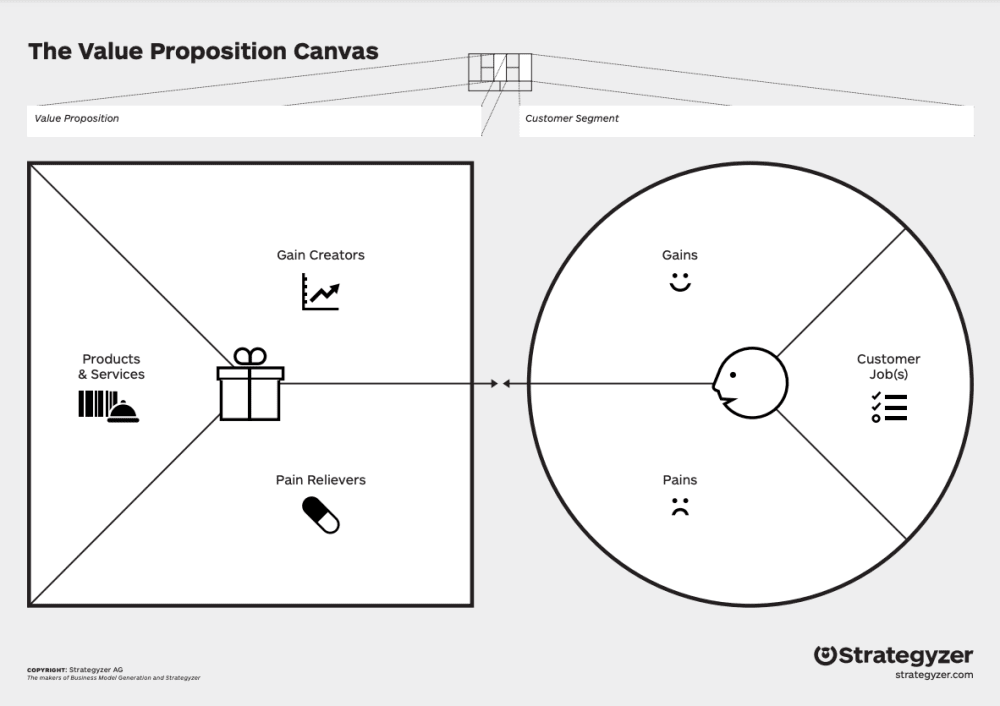How to fit your digital product to real users' needs? Discover the Value Proposition Canvas
Is it worth knowing about and applying the value proposition canvas? We tested the length and breadth of it. Now, we can sincerely recommend it as one of the most powerful tools for precisely fitting a digital product to users’ needs. VPC model helps to analyze and understand high-potential market segments - the ones in need of the solution you’re bringing to market. Read this article to learn more about the Value Proposition Canvas - what it is and examples and benefits of using it.

Table of contents
What is the Value Proposition Canvas? Definition
The Value Proposition Canvas (VPC) is a powerful business model tool that can change your way of thinking about users, their values, and your product-market fit.
At the very beginning of business model creation, it’s crucial to identify the target groups and describe the value that your digital product can bring to them. This often happens by using a broader tool named the business model canvas (BMC). One of the steps in completing the business model canvas is listing the problems your product solves and the customer groups that actually struggle with these problems. This can be analyzed more deeply using the VPC. You can also use the VPC independently from the BMC.
In practice, the VPC is a ready-made template with shapes and icons that guide you through it, and help you enter the right information in response to the right questions. But the process is not as simple as it seems. It requires a high level of business knowledge and market understanding. It’s especially demanding for growing products, and at Boldare, we often support clients, digital product owners, and stakeholders to use the Value Proposition Canvas.
Benefits of the Value Proposition Canvas
The Value Proposition Canvas shows how to organize business efforts around solving real problems for actual users. It draws the potential directions for pivoting business strategy. By doing so, it enables entry to high-potential market segments and improves ROI. With the VPC model,, you can:
- define potential sales and marketing opportunities within new market segments,
- figure out new ways of communicating your product value to users,
- notice specific problems that can be solved with your product,
- gather information about your target users and their actual needs,
- get more clarity for your business strategy and sales directions,
- match your product to the specific needs of your target groups.
All of this leads you towards a successful product-market fit, heightened customer satisfaction, and increased chances of achieving new, lucrative revenue streams. The VPC helps to design and develop a meaningful digital product that addresses users’ needs.
How to use the Value Proposition Canvas?
First, print or download a fillable version of the value proposition canvas template. You can get it directly from the Strategizer website. Then, sit together with your product team, business partners, advisors, consultants, and other parties that have a stake in the questions asked by the template. The process consists of three steps:
- Creating a customer profile
- Creating a value map
- Connecting elements from the above two steps

The value proposition canvas template, source: www.strategyzer.com
Customer profile
The round-shaped area of the canvas is dedicated to your customers. In three separate sections, you should list your customers’ gains, pains, and jobs-to-be-done in their work or life (tasks-to-be-completed).
Don’t forget to include all types of different pains and gains, such as functional, social, financial, and emotional. It should all connect with your business model and the product you want to offer them.
The part for listing jobs (tasks) can be tricky. Think of what your customer is aiming at, and what are their needs and desires. Here are some questions to help you complete these sections:
- GAINS — what makes your customer happy?
- PAINS — what is your customer struggling with?
- JOBS-TO-BE-DONE — what is your customer trying to achieve?
Value map
Next step is creating the value map. The value map consists of three separate sections: products & services, gain creators, and pain relievers. Here, it might be useful to answer the following questions:
- PAIN RELIEVERS — what can you do to help your customers deal with their struggles? How can your product minimize, reduce, or eliminate their pains?
- GAIN CREATORS — how can you help them to achieve their goals and fulfill their gains?
- PRODUCTS & SERVICES — what products and services can you offer them?
Achieving the fit between Customer profile and Value map
At this stage, you will already see some connections between the two created maps. You will be able to recognize the needs, goals, pains, and gains that your product or service is addressing.
Now, connect the elements between the two maps: connect particular pains with the appropriate pain relievers, gains with gain creators, and your offerings with customers’ jobs-to-be-done.
You should use a separate VPC canvas for analyzing each different market segment. This way, you will recognize the ones that are the most valuable to your business. You can also extend the process by creating separate communication strategies for those various segments, based on your outcomes from completing the value proposition canvas. This is what we did when working with one of our American clients, TeamAlert. Here is the story of how we used the VPC model.
The value proposition canvas — an example of implementation
TeamAlert is a company offering a workplace panic button application available for web and mobile devices. We started working on their product in 2019, creating an MVP for a 2.0 version. They then asked for our assistance in fitting their product better into the market.
At Boldare, we create products using a unique approach called full cycle product development. We noticed that what TeamAlert really wanted was to take their product to the next phase — product-market fit (PMF). We decided to organize a series of workshops and use the VPC model as one of the tools to gather and analyze data and get insights into TeamAlert’s undiscovered market segments.
At that time, TeamAlert’s users represented very diverse customer segments with underserved needs, and their stakeholders didn’t know exactly which segments were worth investment in terms of marketing and sales efforts. Our Product Strategist - Aneta Orszewska, led them towards the answer. She successfully implemented the Value Proposition Canvas, helping TeamAlert’s crew to identify and analyze new market segments that may turn out to be a goldmine for them.
From these beginnings we took TeamAlert further, creating hypotheses, talking to their customers (conducting interviews), validating hypotheses, and moving their product closer and closer to the PMF phase. You can read all about it in this article: TeamAlert’s transition from MVP to Product-Market Fit.
After the whole process, TeamAlert’s stakeholders could consciously choose their sales and marketing strategies, each tailored to the specific needs of customers from a clearly identified market segment. The Value Proposition Canvas helped them to expand the company’s portfolio and adjust their product to new users’ needs, enabling hundreds of thousands of dollars in fine-tuned revenue streams.
The VPC model — summary
The Value Proposition Canvas can be applied when analyzing various business models. Can it fail? Of course it can. It’s not perfect and does not always match the specific needs of the market and business under analysis, especially if the business model is flawed. That said, you can apply it both to build a business concept and to research new market possibilities when planning product improvements. The VPC model has numerous benefits and can be used multiple times throughout the business and product development process.
Share this article:






